In this RV Portable AC guide, let's go over what every RV owner has various factors and needs to consider.
We also included a recommendation of the best units in the market today.
What is a Portable Air Conditioner for RVs?
A portable air conditioner is an AC that does not require permanent installation. This flexibility make these units very versatile.
Reasons to use a portable AC for your next RV trip:
- Cost: the biggest advantage that portable AC have over rooftop units is that they are relatively cheap.
- Cleaner air: many units have a ventilation process that filters the air which can help people who have problems with allergies or sleeping.
- Mobility: portable AC’s will have wheels which makes it easy to move around the AC. This is great since it allows you to focus the cooling to specific rooms.
- Good Backup: if you’re out in the scorching heat, it’s good to have a backup AC for peace of mind. Especially if the rooftop AC in your RV is unreliable.
- Dehumidifier: depending of where you are, the dehumidifier feature can be a blessing.
- Power Consumption: Rooftop AC consume a lot of power which can be a concern if your RV is off-grid. With a portable AC, you can concentrate the cooling to where you really need it and consume less power. This is especially useful if you’re relying on solar panels for your energy since solar panels don’t produce energy at night. So by limiting your AC power consumption at night, you can extend the use of your RV storage battery.
Types of Portable AC for Recreational Vehicles
There are three major classifications of portable AC units. Each of these classifications has varying features and benefits. Below is a breakdown of what each type to help choose what’s best for you.
1. Ventless units
This is the simplest and most mobile AC type included in this list. Essentially, you just need to connect the unit to an AC (alternative current) power source, and it will start pulling warm air and expelling cool air out the back. These are especially useful if you don’t have access to a window.
How do Ventless AC work?
They work by using evaporative cooling, also known as adiabatic cooling. During this process, the energy from hot air is used to convert liquid water into gas.
Here’s a step by step breakdown:
- The AC unit pulls in hot & dry air from the room.
- It passes the hot & dry air through water soaked cooling pads.
- The water in the pads is evaporated by absorbing energy (aka heat) from the air. The water serves as a refrigerant. Note that this works because water requires a lot of heat to evaporate.
- Cooler and humid air is expelled from the back via a fan.
As you can imagine, ventless AC units work best when the air is dry. This means that they don’t work as well in humid climates. Additionally, after running for a while, the air in the room might become overly humid. So it’s recommended that a window/door is open that allows for dry air to circulate into the room.
While these units are very convenient, they are limited in their cooling capacity. They will provide a cool breeze for one person to enjoy but are not going to lower the overall temperature inside of the RV.
2. Vented units
Vented ACs are perhaps the most common and preferred unit in the market. Unlike ventless units, they can cool down the temperature inside of the RV. They also consume a lot less power than rooftop units and are easier to install than window units.
They work by removing the heat from the indoor air and expelling it outside via a hose. Most vented AC units work well with slide-up windows as the frame can be placed to secure the hose.
A vented AC unit is relatively affordable, adding to the reasons why these air conditioners are sought after. However, as the name implies, these units are less mobile than their ventless counterparts because they require efficient ventilation during installation.
Another drawback is that compared to other portable units, vented portable air conditioners are a bit louder because their compressors will be running inside of the RV.
How do vented AC work?
Here is an easy-to-follow breakdown.
A portable air conditioner has three main parts: a Compressor, a Condenser, and the Evaporator.
- A Compressor squeezes the refrigerant gas into a small space which greatly increases the pressure its under. This in turn will make the refrigerant get very hot.
- After the refrigerant has gotten very hot, it passes to the Condenser. A Condenser is designed to cool down the refrigerant gas down as quickly as possible and condense it to a liquid.
- NOTE: The Condenser cools down the refrigerant gas by increasing its surface area and having a fan blow air through the pipes it’s in.
- Since the refrigerant has been pressurized so much, its boiling point has greatly increased. This means that it will condense to a liquid at around 130-150 degrees Fahrenheit.
- This really hot liquid is then transferred to the Evaporator via a metering device.
- The Evaporator will dramatically decrease the pressure of the refrigerant. As the pressure on the refrigerant liquid is decreased, its boiling point goes way down. This causes it spontaneously to evaporate because now it’s too hot to remain a liquid.
- Here is the key part: to change back from liquid to gas it needs to get energy from somewhere.
- It gets this energy from the room! Basically, the AC is sucking the heat from the room so that it can convert the refrigerant from a liquid to a gas.
- The refrigerant gas is then passed to the compressor to start the whole process again.
As you can see, a lot of heat is generated during this process which is why you need an exhaust hose. Otherwise, you will just be transferring the same heat that was absorbed from the room back into it.
3. Window Units
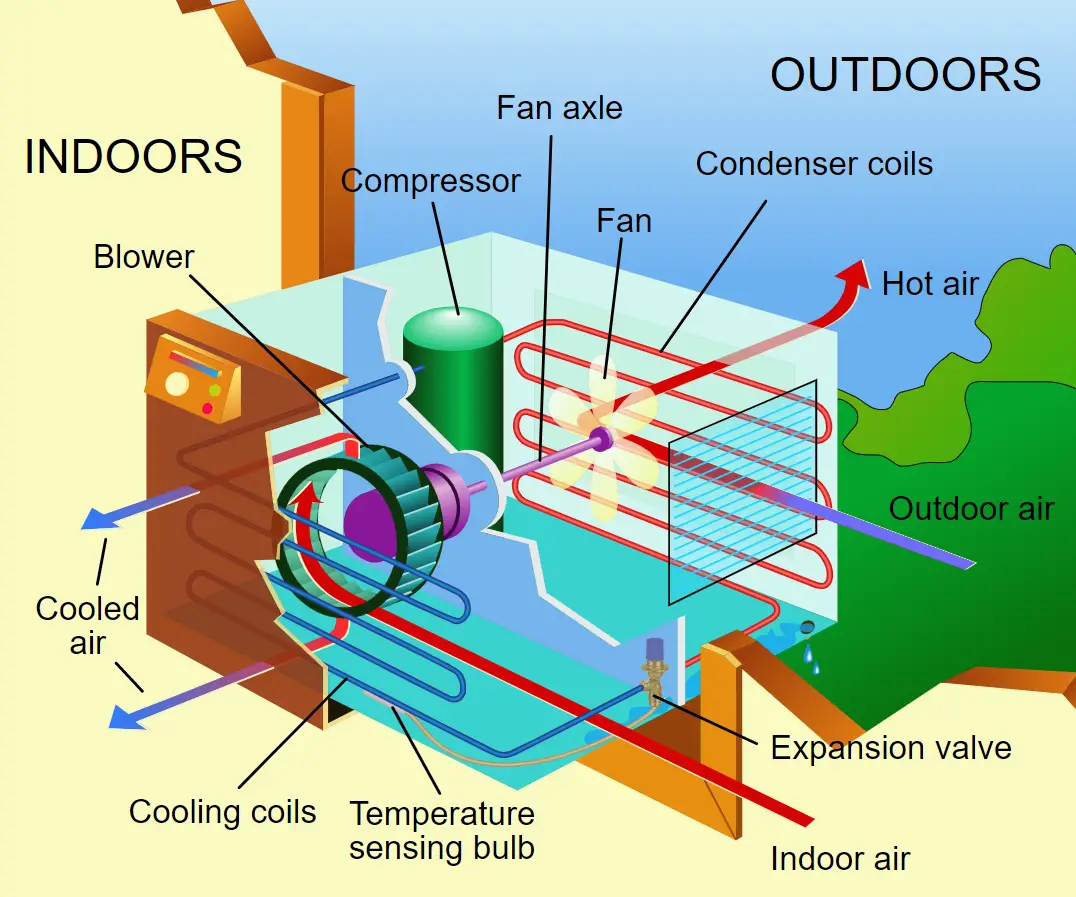
Technically, window ACs are not portable since they must be installed on one of the RV windows. However, window AC units are compact and have a greater cooling ability in comparison to the other types in this list.
They work the same as the vented portable AC units. They have all the same components, but they are crammed into a smaller space (as shown in the picture above). The heat created is vented via the back of the unit to the outside, and the fan cools and re-circulates the indoor air.
Since they can cool down a room faster than a vented portable AC unit, they are also more energy efficient. In addition, these AC units are quieter and easier to maintain.
If you opt for a window AC for your RV, it is important to note you will require some level of customization to properly fit the unit in the allocated window space. This can be burdensome is you’re constantly on the move since you’ll have to uninstall and then reinstall the unit every time. This makes window ACs an ideal option for RV owners' intent of staying in one location for an extended period.
Best Portable AC for RV
Hopefully after reading the descriptions above, you have decided which type of portable AC works best for your needs. Below our team has included the best AC units on the market.
Our team evaluated the different choices in the market by considering the technical specifications and the customer reviews among different ecommerce platforms. We are sure that our readers will be satisfied with any of the products below.
Best Ventless Portable AC for RV
HESSAIRE MC18M Portable Evaporative Cooler
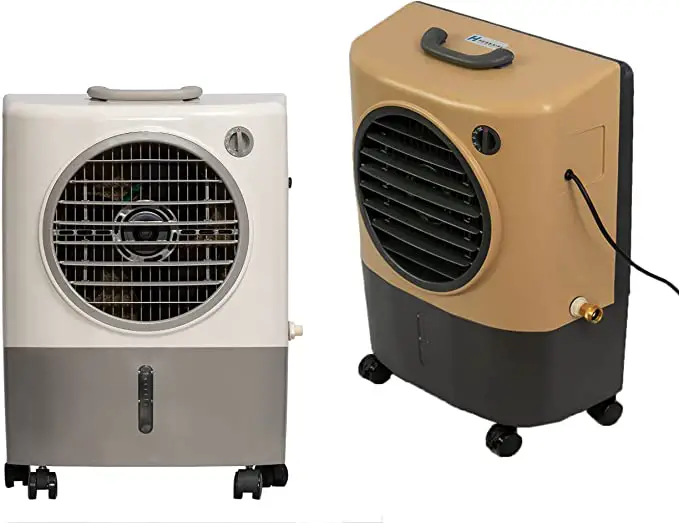
Don’t let this unit’s cheap look fool you. This is a top-quality unit and there’s a reason it’s been a best-selling evaporative cooler in Amazon for the past 2 years!
Two things to consider, this unit is noisy and big compared to the other ventless options out there. This video will give you an idea of how loud it can get.
However, if you want an efficient evaporative cooler that will provide cooling air for hours, then look no further!
- Dimensions: 20 x 10 x 28 inches
- Cubic Feet per Minute (CFM) Airflow: 1300, good to cover up to 500 Sq Ft
- Weight: 16 pounds
- Water Gallon: 4.8 gallons
What are customers saying about this product?
- How long will it run before the water runs out? Depends on how humid the air in the room is. The lower the humidity, the faster the water will evaporate. However, on a hot day with 20% humidity, and the fan on high, the water will last about 4 hours. If the fan is on a low setting, the water can last 7-8 hours.
- What should I do before storage? Prior to putting your cooler away for winter, always: a. Drain the tank and wipe out clean. b. Clean the filter c. Reassemble and run-on FAN ONLY for 30 minutes to dry out the filter.
- How much energy does it consume? The high efficiency 0.7A motor allows it to operate on vehicles with 115V power supply making it good for tailgating, camping, pool parties and other outdoor events.
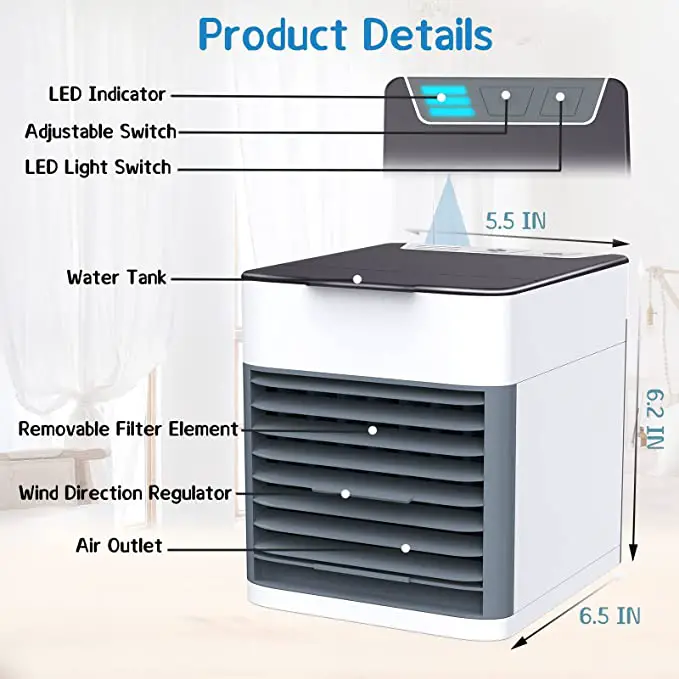
This small but powerful evaporative cooler is the ultimate cooler for personal comfort. With its multiple charging options, all you need is some cool water and it will start cooling the air around you in seconds.
What we really like about this unit is that the filter element is removable. In other similar products, you are only able to clean the outside of the product. Over time, dust accumulates, and they can even start to smell. So it is nice that Teezira allows you to remove the filter.
- Dimensions: 7 x 6.8 x 6 inches
- Weight: 1.7 pounds
- Water Gallon: 500ml
What are customers saying about this product?
- How long will it run before the water runs out? One refill will last about 8 hours.
- How is it powered/charged? It take a USB power supply, so it is very useful for indoor and outdoor use. It can be connected to adapters, power banks, computers, car chargers for convenient use.
Best Vented Portable AC for RV
ECOFLOW Wave Portable Air Conditioner
Due to its nifty features, the EcoFlow Wave is the best vented portable AC for an RV. Hands down!
Its small size and light weight allow for maximum mobility. Perfect to take with you any RV trip! Additionally, its 1008Wh battery and four ways to charge make it ideal for off-grid usage. You can charge it with solar, a portable power station, a car socket or from a wall socket.
It might be on the pricier side, but if you want to take advantage of the latest technology, then it’s worth it! Plus, EcoFlow is one of the most trusted brands in this sector so you can be sure this product is top class.
- Dimensions: 20.39 x 12.2 x 16.38 in
- Weight: 38.58 lbs
- EER Rating: 3
- Noise Rating: <55dB
- Price: $$$$
- Check out the installation video here!
What are customer asking about this product?
- Can it be powered by solar panels? Yes, it can! You can use up to 200W of solar panels to keep the Wave battery topped off. It would only take 5 hours to charge up the add-on battery using 200W solar panels. You can check out the ECOFLOW power station with solar panels here. Here at SunvivalGuide we really love that it can be fully powered by 200W solar panels.
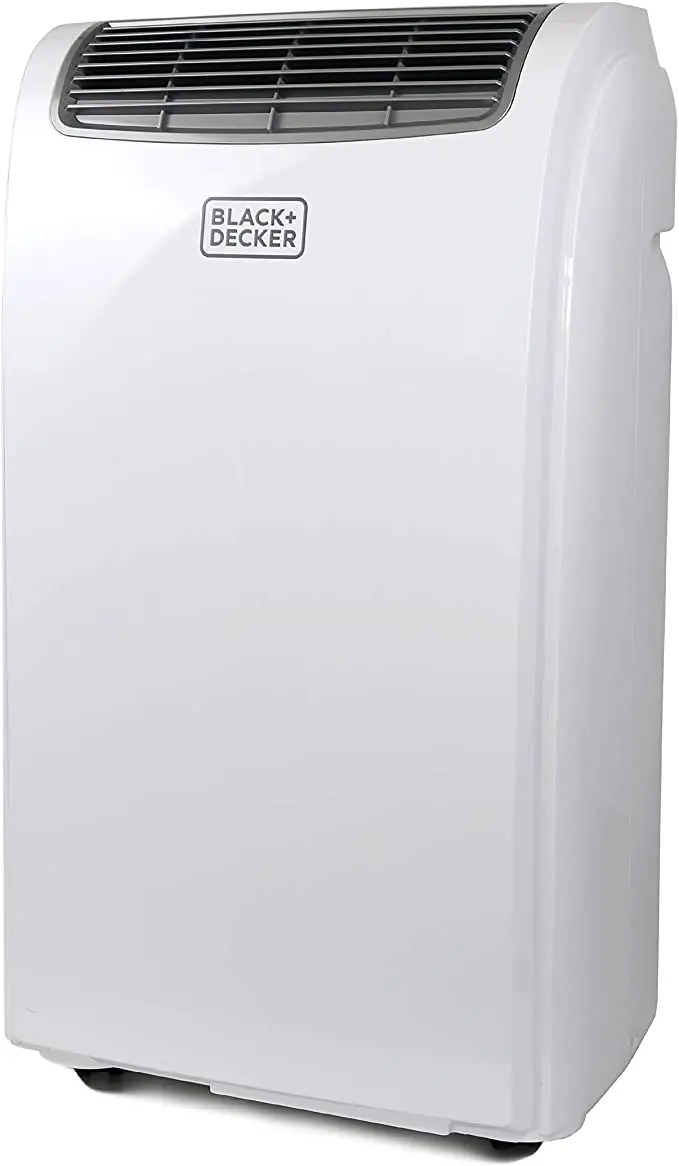
This popular model is known for being easy to install and its durability. Multiple verified customers have used this unit 2+ years and say it still works great. It’s no surprise that it’s one of the best rated portable AC units in the market today!
This unit is small, so cooling power is minimal, but it will get the job done in smaller areas making great for RVs.
- Dimensions: 26 x 16.5 x 11.5 inches
- Weight: 52.9 Pounds
- EER Rating: 3.25
- Noise Rating: >41dB
- Price: $$
- Check out the installation video here!
What are customers asking about this product?
- What is the width of the window vent? width of window kit is about 6 1/2 inches and length is min of 20.5 and extending to a max of 59 inches.
- Does this unit have a drip pan that needs to be emptied? There is a drain plug in the back of the unit to drain condensation. However, the unit is designed to evaporate this water and send it out of the exhaust hose as moist air. It should only require to be drained in very humid conditions and at the end of the season. Most customers have not had a problem with this.
- Will the condensation pan overflow? You cannot accidentally overflow the condensation collection. An LED warning light will indicate “Drain Pan Full” and the unit will stop until it’s drained.
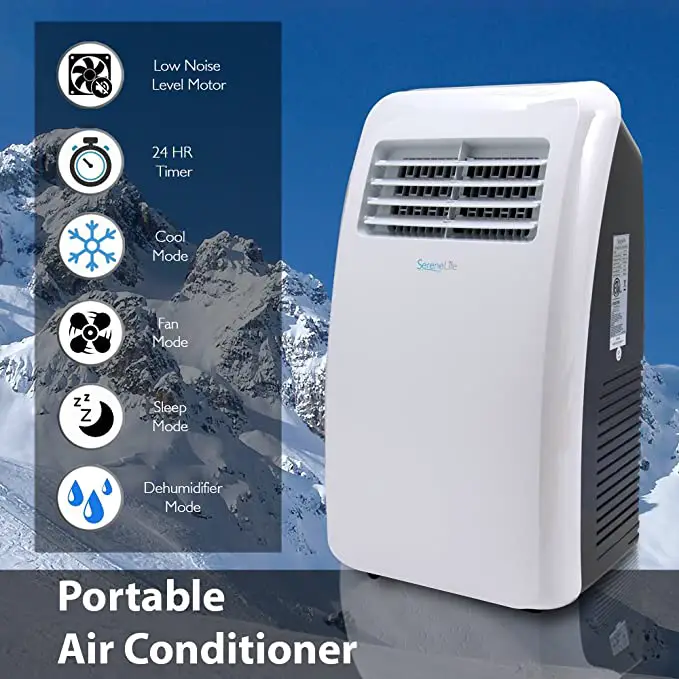
SereneLife is a reputable brand in portable air conditioners. In customer reviews their products regularly outperform better known brands such as Honeywell and LG. In fact, this portable AC has been on the Amazon best sellers list for the past 3 years.
- Dimensions: 13.8 x 14.6 x 27.2 inches
- Weight: 46.3 Pounds
- EER Rating: Not included in the owner’s manual. However, based on its specifications our team estimates that its around 3.
- Noise Rating: 55-57 dBa
- Price: $$
- Check out the installation video here!
What are customers asking about this product?
- How wide can the window be for the window mount kit to accommodate? The window mount without the extension is 26.6''. However, with the extension the range is 37.4'' to 50'' inches. If your window is larger than 26.6 but smaller than 37.4, the window mount will not work as designed. You either must cut the extension or fill in a gap with something.
- How many watts does it use on high setting? 1100 Watts on Highest Settings
700 Watts on Lowest Settings
Best Window AC for RV
Frigidaire Window-Mounted Room Air Conditioner
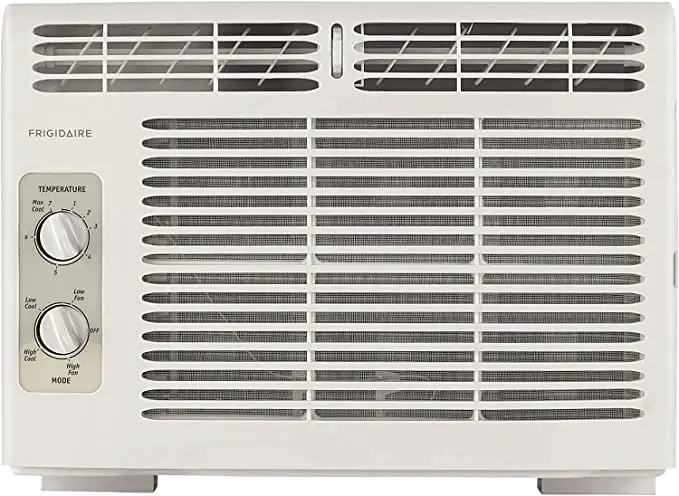
Our team believes that Frigidaire is the best window mounted unit you can get. Don’t just take our word for it, it’s the #1 Best Seller in Amazon for Window AC. They are truly incredible!
They have a filter to prevent dust and debris from coming into your RV. The filter is removable, which makes for very easy cleaning.
It’s also relatively lightweight which makes carrying and installing easy. You can check out a installation guide video here:
Your purchase will include SpaceWise Adjustable side panels. For better installation, consider getting these mounting brackets and side panels.
- Dimensions: 16 x 15.25 x 12 inches
- Weight: 35.27 Pounds
- EER: 12
- Noise Rating: 51.3 dBa on the lowest fan setting
What are customers saying about this product?
- What are its full dimensions? For the 5,000 BTU unit, these are the dimensions:
Width 18-1/2"
Cabinet Depth (w/ Front) 15-1/2"
Cabinet Height 13-7/32"
Cabinet Depth 15-1/2"
Cabinet Depth (w/ Front) 15-1/2"
- How loud is it? The unit is remarkably quiet! It sounds like something you can sleep through no problem. It sounds like white noise - kind of like a hotel air conditioner but it is a constant hum so it won't bother most people. It does not rattle. Keep in mind, this is not a $500 air conditioner and it does make noise! It is just soothing noise because it is making the air cool and happy.
FAQs
What are BTUs?
The British Thermal Unit (BTU) is a measurement unit used to determine the cooling efficiency of your AC. In other words, BTUs outline how much space the AC unit can cool.
BTU rating is the main factor to consider when selecting a portable AC. You want to make sure that the unit you’re buying can cool your entire RV. Basically, larger RVs require AC units with a higher BTU rating.
How many BTU do I need for my RV?
You can easily calculate the square footage of your RV to determine the perfect AC unit. For most RV sizes, you need about 60 to 80 BTUs per square foot. Here's some more info on how to determine the right BTU for your RV.
You can also use our nifty chart below to estimate. The standard RV BTU rating is 13,500 which is enough to cool around 600 square feet.
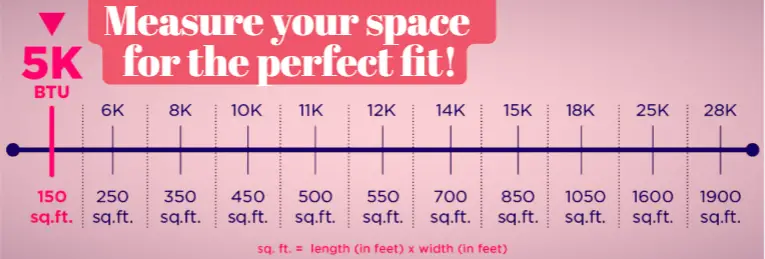
Things to consider:
- Reduce the capacity needed by 10% if the RV is heavily shaded
- Increase the capacity by 10% if the RV is under a lot of sun
- Add about 600 BTUs for every additional occupant in the RV
What is an EER rating?
An Energy Efficiency Ratio (EER) is a value used by the heating, ventilation, and air conditioning (HVAC) industry. EER is used to determine how much cooling power an AC gives for a specific quantity of electrical energy.
This ratio is determined by two quantities; the energy output (cooling) to energy input (electricity consumed). Energy output can be measured in BTUs, while the energy input can be determined from the Watt Hours.
Example: if a 5,000 BTU AC consumes 1,200 watts, it’s EER is 4.2 (5,000 BTU/1,200 watts).
In most cases, the EER rating is placed as a label on the side of your portable AC unit. It is sometimes labeled as ‘Energy Guide.' It is vital to consider the EER rating on a portable AC unit before buying one.
A higher EER rating means the unit will use less power when cooling a given area. This energy efficiency translates to saving money on utility bills.
What is SEER?
SEER stands for Seasonal Energy Efficiency Ratio. Much like the EER, it is the ratio of the cooling output to the electricity input, but the main difference is that the SEER is calculated over a whole summer season.
The SEER is calculated to ensure that the efficiency rating is averaged out throughout the season. On the other hand, the EER gives more of a quick snapshot of the efficiency of the air conditioner, rather than the complete picture of energy savings through a longer period.
When you are buying the best portable AC for your RV, you'll notice units with higher EER and SEER ratings are pricier. However, this cost will be recouped over the long run thanks to their energy efficiency.
How do you install a portable AC?
The specifics of how to install a portable AC to your RV largely depend on the unit type you buy. Ventless units require little-to-no installation as you can just set them on the floor, plug them in, and they're ready to start working.
Other units, like the window AC, require a bit more effort to get them working. Fortunately, most ACs come with a guideline and a complete installation kit for a seamless job. You can also learn more about how to install window air conditioners here.
How many ACs does your RV need?
If your RV is less than 32 feet, a single AC unit will be enough. As the RV gets bigger, so does the requirement for another AC unit. Additionally, if the RV has multiple rooms or compartments, you'll likely need an additional air conditioner to maximize airflow throughout the vehicle.
You can have more than one AC but operate them at different intervals, depending on the climatic conditions.
Can you run a portable AC unit all day?
The answer will vary depending on who you ask. Most experts recommend running the AC throughout the day as opposed to intermittently. This is because it takes less energy to maintain a room cool than to cool it down once its hot.
However, it is paramount to mention that running your AC unit at maximum level for an entire day will consume more power and likely lead to inefficiency. If you're in an environment that requires extended AC use, try setting it on eco or auto mode.
Do you have to put water in a portable AC?
Evaporative coolers require regular water or ice. However, portable ACs don't necessarily require water addition unless you're using a very basic model. In most cases, ACs need water to be removed. This feature has been automated on most modern air conditioning units.
If you're dealing with earlier portable AC models, you may need to manually empty the collection task. Recent designs have incorporated automatic mechanisms to collect any excess water build-up and get rid of the water.
What's the smallest RV air conditioner?
If you just want a device to cool you down, then check out our list of ventless AC units. Those units are small enough to be placed on a coffee table but will not cool down the temperature in the RV.
For something that will cool down the RV, the EcoFlow Wave is the smallest RV AC. If that’s too expensive for your budget, then consider the Black+Decker Portable Air Conditioner. With dimensions of 26in x 16.5in x 11.5in it’s the second smallest in the market today. Also, it only weighs 52.9 pounds.
With dimensions of 27.1in x 12.3in x 12.5in, the LUKO Portable Air Conditioner is slightly taller but will take up overall less space (it’s thinner). It also only weighs 52 pounds.
How many solar panels does it take to run an RV air conditioner?
Check out our full guide here! We go through the math breakdown, using 100-Watt and 300-Watt solar panels as examples with different sizes of air conditioning units.
Are portable ACs worth it?
Short answer, yes! We recommend using a window AC unit since they are the most effective at cooling down a room and energy efficient. However, if your window can’t hold a window AC then we recommend a vented portable AC.
A ventless portable AC will offer mild cooling comfort in the form of a cold breeze. However, we don’t think it’s worth it.
Do portable AC use more electricity than window AC?
Yes, portable AC units use more electricity than window AC units. The average EER rating for portable air conditioners is 8.5 compared to the average for window AC units of 12.
How long can the exhaust hose be on a portable air conditioner?
The exhaust hose on a portable AC can be extended up to 20 inches. However, to avoid the transfer of heat back to the room, its recommended to avoid lengths greater than 12 inches and multiple bends. For more information, please refer to the manufacturer manuals.
Do portable air conditioners create carbon monoxide?
Portable air conditioners that run on electricity cannot produce carbon monoxide.
